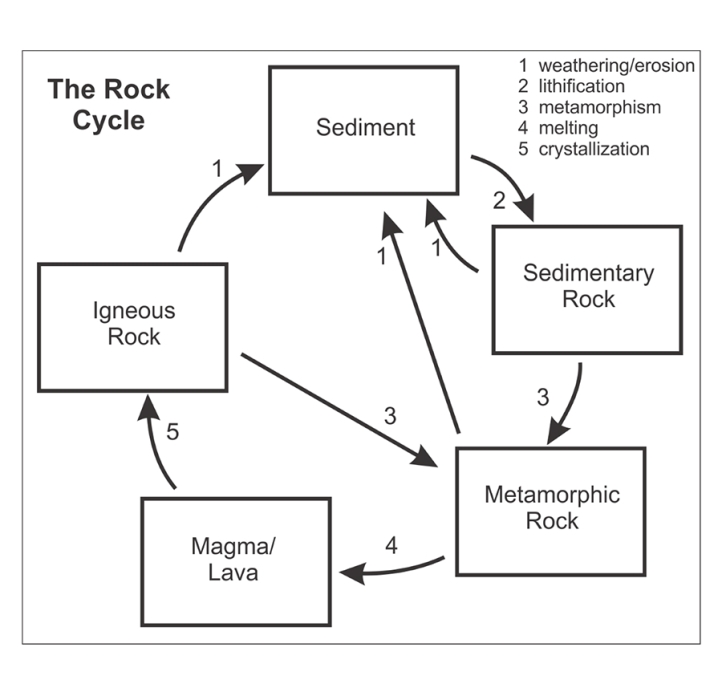
An Immersive Field-Like Experience
Buffalo State's Outdoor Geology Classroom provides an immersive field-like experience where students and visitors learn about Earth processes using a purposely arranged combination of natural and construction materials. This outdoor classroom is based on the cyclic production of materials in the Earth's outermost layer (the crust).
The display is a centerpiece of the newly renovated/constructed Science and Mathematics Complex. More importantly, it is a teaching tool used for introductory-level class meetings and other geology instruction.
Inspiration
Geology is an “outdoor” science.
Earth materials, like rocks, lava, and sediment, are collectively the record of long-term Earth processes driven by the motion of tectonic plates.
At Buffalo State, geology field experiences over the last 50+ years come primarily from field trips.
To bridge gaps between the field and the laboratory, Buffalo State Earth Sciences faculty members have used the large number and variety of rocks on campus used for decorative stones and building materials sourced from across the United States.
The Outdoor Geology Classroom is a process-oriented outdoor geology display based on the Rock Cycle that provides that spatial (field-like) relationship between the materials used.

Geological Components and Processes Represented
The illustrative signage is used as a guide for all visitors and includes background information on the Rock Cycle and tectonic plate motions, as well as explanations of the materials used and the five different Earth materials they represent:
- magma/lava
- igneous rock
- sediment
- sedimentary rock
- metamorphic rock
Numbered arrows on the sign illustrate the five connecting Rock Cycle processes:
- weathering and erosion
- lithification
- metamorphism
- melting
- crystallization
The Rock Cycle is presented inside the circle, and representative rocks are outside the circle on the opposite side of the seating wall.

The Rock Cycle
Weathering and erosion (1), and metamorphism (3) connect several components in more than one path.
The other processes are one way only between just two components. Sedimentary rocks are the only product of lithification (2) of sediment. The process of melting (4) to form magma/lava is exclusive in metamorphic rocks because only metamorphic rocks get hot enough in the Rock Cycle to melt.
Metamorphic rocks are the only rocks to be buried deep enough. [Melting of rocks occurs as a result of meteor impacts, but impacts from space rocks are not part of the Rock Cycle.]
After melting has produced magma/lava, only igneous rocks are formed from crystallization (5) of the magma/lava
- magma/lava: acid-stained concrete
- igneous rock: metamorphic rock pavers with granite veins
- sediment: exposed aggregate concrete
- sedimentary rock: limestone pavers
- metamorphic rock: late pavers
Boulders
For Magma/Lava
A. vesicular basalt – it was lava before crystallizing
B. massive quartzite – for minerals found in many rocks
For Igneous Rock
For Sediment/Sedimentary Rock
D. granite– for sediment, because much of the components weather to sediment
E. cross-bedded sandstone
F. quartz sandstone
For Metamorphic Rock
GES 101 INTRODUCTORY GEOLOGY
GES 102 HISTORICAL GEOLOGY
GES 103 INTRODUCTORY GEOLOGY LABORATORY
GES 104 GEOLOGY OF THE SEVEN SUMMITS
GES 123 ENVIRONMENTAL EARTH SCIENCE
GES 124 GEOLOGIC HAZARDS
GES 200 FIRST YEAR GEOLOGY EXPERIENCE
GES 201 PHYSICAL GEOLOGY
GES 202 EARTH AND ENVIRONMENTS THROUGH TIME
GES 303 MINERALOGY
GES 306 SEDIMENTOLOGY AND STRATIGRAPHY
GES 307 GEOMORPHOLOGY
GES 401 IGNEOUS AND METAMORPHIC PETROLOGY
GES 450 FIELD GEOLOGY
SCI 100 CONTEMPORARY SCIENCE
SCI 105 PHYSICAL SCIENCE FOR NONSCIENCE STUDENTS
SCI 311 PROBLEM SOLVING IN PHYSICAL SCIENCE
SCI 313 PROBLEM SOLVING IN EARTH SCIENCE
SCI 335 OUTDOOR SCIENCE EDUCATION

